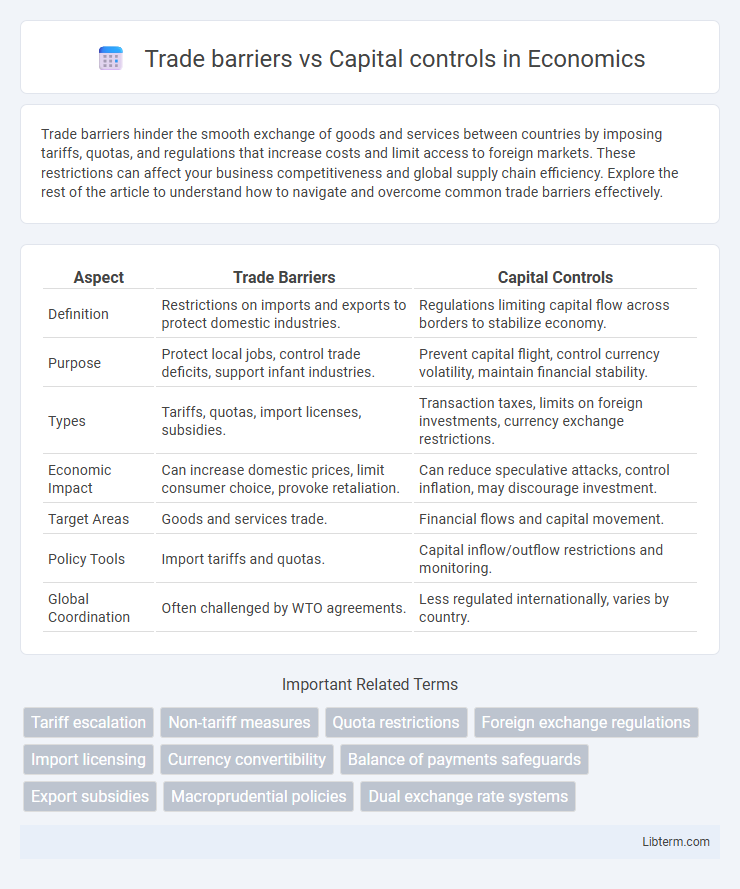Trade barriers hinder the smooth exchange of goods and services between countries by imposing tariffs, quotas, and regulations that increase costs and limit access to foreign markets. These restrictions can affect your business competitiveness and global supply chain efficiency. Explore the rest of the article to understand how to navigate and overcome common trade barriers effectively.
Table of Comparison
| Aspect | Trade Barriers | Capital Controls |
|---|---|---|
| Definition | Restrictions on imports and exports to protect domestic industries. | Regulations limiting capital flow across borders to stabilize economy. |
| Purpose | Protect local jobs, control trade deficits, support infant industries. | Prevent capital flight, control currency volatility, maintain financial stability. |
| Types | Tariffs, quotas, import licenses, subsidies. | Transaction taxes, limits on foreign investments, currency exchange restrictions. |
| Economic Impact | Can increase domestic prices, limit consumer choice, provoke retaliation. | Can reduce speculative attacks, control inflation, may discourage investment. |
| Target Areas | Goods and services trade. | Financial flows and capital movement. |
| Policy Tools | Import tariffs and quotas. | Capital inflow/outflow restrictions and monitoring. |
| Global Coordination | Often challenged by WTO agreements. | Less regulated internationally, varies by country. |
Introduction to Trade Barriers and Capital Controls
Trade barriers restrict international trade through tariffs, quotas, and import bans, aiming to protect domestic industries and regulate economic interaction between countries. Capital controls limit cross-border financial flows, managing currency stability and preventing capital flight by restricting foreign investment and money transfers. Both mechanisms serve to influence economic policy but target different aspects of international economic exchange--goods and services versus capital movement.
Defining Trade Barriers: Types and Mechanisms
Trade barriers are government-imposed restrictions that limit the free exchange of goods and services across borders, primarily including tariffs, quotas, and import bans. Tariffs increase the cost of imported goods, while quotas restrict the quantity allowed, and import bans completely prohibit certain products. These mechanisms protect domestic industries, control trade deficits, and influence international market competition.
Understanding Capital Controls: Tools and Purposes
Capital controls are regulatory measures implemented by governments to restrict or manage the flow of foreign capital in and out of a country's economy, including limits on foreign exchange transactions, restrictions on cross-border investments, and controls on repatriation of profits. These tools aim to stabilize the financial system, prevent capital flight, protect domestic industries from volatile external shocks, and maintain monetary policy autonomy. Unlike trade barriers that primarily target goods and services, capital controls focus on regulating financial assets to safeguard economic stability and promote sustainable growth.
Key Differences Between Trade Barriers and Capital Controls
Trade barriers restrict the flow of goods and services across borders through tariffs, quotas, and import licenses, impacting international trade volumes and pricing. Capital controls regulate the movement of financial capital across countries by imposing restrictions on currency exchange, foreign investments, and capital transfers to stabilize economies and prevent capital flight. The key difference lies in trade barriers targeting physical goods and services, while capital controls focus specifically on financial assets and capital flows.
Economic Impacts of Trade Barriers
Trade barriers, such as tariffs and quotas, directly increase the cost of imported goods, reducing consumer choice and market efficiency while protecting domestic industries from foreign competition. These restrictions often lead to trade retaliation, decreased export opportunities, and slower economic growth due to diminished international market integration. In contrast, capital controls regulate cross-border investment flows, impacting financial market stability but not directly altering goods prices or trade volumes.
Economic Effects of Capital Controls
Capital controls influence the flow of money by restricting foreign currency transactions and cross-border capital movements, which can stabilize exchange rates and protect emerging markets from volatile capital flight. These controls often reduce speculative attacks on the currency and preserve monetary policy autonomy, though they may also limit foreign investment and slow economic growth. Unlike trade barriers that directly affect goods and services, capital controls target financial assets, impacting liquidity and investment patterns within the economy.
Trade Barriers and Capital Controls in Global Markets
Trade barriers such as tariffs, quotas, and import bans restrict the flow of goods and services across borders, impacting global market efficiency and international competition. Capital controls regulate the movement of investment funds by imposing restrictions on currency exchange and cross-border capital flows to stabilize economies and manage financial crises. Both trade barriers and capital controls influence global market dynamics by altering trade balances, investment patterns, and currency stability.
Policy Objectives: Why Countries Use Trade Barriers or Capital Controls
Trade barriers are implemented to protect domestic industries from foreign competition, safeguard jobs, and promote economic stability by regulating imports and exports. Capital controls aim to prevent excessive capital flight, maintain exchange rate stability, and reduce systemic financial risks by managing cross-border capital flows. Both policy tools serve to shield national economies from external shocks and support long-term growth objectives.
Case Studies: Real-World Applications and Outcomes
Trade barriers such as tariffs and quotas have been extensively studied in case studies like the U.S.-China trade war, revealing significant impacts on global supply chains and consumer prices. Capital controls implemented in countries like Malaysia during the 1997 Asian Financial Crisis demonstrated how limiting foreign capital flows can stabilize currency markets and shield economies from speculative attacks. Empirical evidence from these real-world applications highlights the trade-offs between protectionism and economic openness in managing national economic policies.
Future Trends in Trade Barriers and Capital Controls
Future trends in trade barriers indicate an increase in digital trade regulations and environmental standards, reshaping global commerce frameworks. Capital controls are expected to evolve with greater emphasis on managing cross-border data flows and mitigating financial risks amidst geopolitical tensions. Advances in technology and shifting economic policies will drive more sophisticated mechanisms balancing trade openness and financial stability.
Trade barriers Infographic

 libterm.com
libterm.com